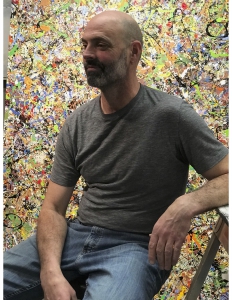David Sieh’s Method
The problem I have with most art is that at first glance most art looks like art. Because it looks like art I’m familiar with, it becomes very easy not to stop and look hard to see what it may have to offer. Most art invites me to ignore it and fall back on my art historical knowledge and simple place it in a context of history without giving it the time and space to find what it really has to offer that might be unique. I’ve had the experience of spending three hours rushing through an art museum, viewing hundreds of significant art works only later to realize that I have not really seen anything well or have any specific observations or insights into the collection I just viewed.
I’ve been re-teaching myself to experience fewer works of art but to slow down and really look. Now I go into an art museum, spend three hours and look perhaps six pieces of art, looking at each chosen piece for as long as twenty minutes and as a result I find myself thinking about those pieces for weeks afterwards. I’ve made some exciting discoveries and also learned to judge some art as not very good even though it is by a famous artist. I’m old enough to not care.
Recently I have been visiting a Sioux Falls artist, David Sieh at his studio to talk and look at what he makes. David is a mid-career artist; he’s in his early fifties and has been at it for over twenty-five years. David’s art is not easily put into neat categories, he paints some realistic scenes, he does a number of styles that look like the school of American abstract expressionism. At first glance the paintings seem to be scaled down versions of the classics we all know. The paintings are smaller than their predecessors perhaps are made to fit in suburban family homes, not corporate lobbies. Of course they are also scaled to the small studio David occupies.

Upon further study differences in approach, style and meaning emerge that begin to frame a different conversation than the ones that come out of looking at the great masterpieces created by Pollack, Rothko, Motherwell and others. For instance if you really study David’s drip paintings, that at first glance remind you of Jackson Pollock’s famous works, you’ll discover the similarities are superficial.
In David’s studio there are perhaps ten completed drip paintings, all different sizes but similar to each other in most other respects. They are all painted on masonite panels, they all have a smooth industrial surface upon which he laid down his drips and gestured splats in an orderly fashion using the same colors and materials over and over. Each of these paintings regardless of their size has been created from the same distance and with the same tools and in the same order of application. If you cut out a six inch square from each of the ten painting and place them next to each other, they would appear to be from the same work.
In each of these paintings, David has developed and followed a rule based recipe or methodology and seems to be asking the question, how do the paintings differ, why does one seem more attractive or successful than another? This approach to art making, a disciplined, non-expressive, rule based process is often aligned with phenomenology. David is willing to ask a question and make pieces over and over until he has satisfied some question deep inside himself. Although to a casual observer, these works may appear to be Pollack like, in truth they are nothing like the emotional outpouring of Pollack’s classic drip paintings. They are a controlled study of what happens when you limit your options and give the process all the room needed to produce results that satisfies the artist’s curiosity. I like this approach. His paintings can be more like evidence than expression. If you give the work enough time to figure all this out, you will be delighted.


